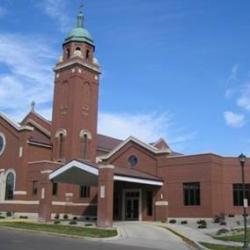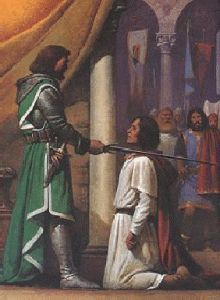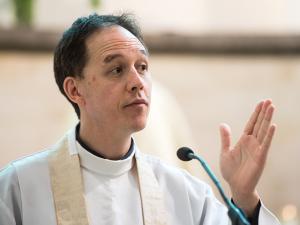
A Japanese foreign exchange student went to Sunday Mass with us and gave me most of the title of this piece. I asked her what it was like, and she responded, “We sit, we stand, we kneel; we sit, we stand, we kneel.” Catholic worship does tend more toward exercise than some others. Each of these postures, sitting, standing, kneeling, and walking, has its own meaning to lend to the Liturgy.
Whenever I read something about postures in liturgy, kneeling gets its fair share of commentary, especially kneeling at the reception of Communion. The writer beautifully sets out the meaningfulness of kneeling. In this post I intend to make up for the neglect of some other postures—sitting, standing, and walking, while paying due attention to kneeling as well. All are important; each expresses its part of the meaning of the whole liturgy.
When it comes to Communion, I believe the current majority practice of standing to receive is a good fit for what is happening at this point. I don’t recall ever hearing that case made for standing. That is what I will attempt, inviting your response, especially if your current preference is inclining toward kneeling.
Sitting, Standing, Kneeling
Switching rather often among these three postures is a hallmark of Catholic Liturgies. We get some exercise that way, but seldom do we talk about what the postures mean. I’m convinced that even though we don’t think about it the postures do add in important ways to the meaning of Liturgy.
Consider sitting. It’s mostly, though not entirely, a passive posture. It’s a good time for receiving something like the Word of God in an Old Testament reading or a letter from the New Testament. It’s a good position for listening to the presider or deacon explain and apply the meaning of the Mass readings. Sitting is also a good posture for waiting. Waiting is the thing to do during the rite called the Preparation, when we get the altar and the gifts ready for the offering.
We sit for most of the readings, but we stand for the Gospel. What gives here? Isn’t this also something we receive in a mostly, again not entirely, passive mode? Well, no. The Gospel is different. You can tell by the way we honor it, perhaps with a special Book of the Gospels. We carry it in procession, sometimes with incense. The Gospel is the Word that has made us who we are. We are Gospel people. At this part of the Liturgy of the Word, we don’t just receive the good news; we are this good news and have been since our Baptism. No hesitating or pretending we aren’t what God made us to be. No trying like Moses to get out of God’s call. We absolutely have to stand as we are able. We stand up to be this Gospel.
Standing is the posture in which we are ready to throw ourselves into a project. We are ready to move. Liturgy means “work of the people,” and standing is a posture for working. Most of the assembly’s short responses are sung or spoken while standing. We give the gesture of peace, an important work, standing.
Kneeling, we hear often, is a posture for reverence and awe in the presence of God’s majesty. I’d like to add another note that I think is very appropriate for Liturgy. Kneeling is what a person did in olden days when devoting oneself to the service of the king. You would kneel to hear the words “I hereby dub thee knight”; and you’d be officially enrolled into the king’s service. That aura of devotion to service, I hope, still lingers in the back of our minds when we kneel at various parts of the Liturgy. It is part of the meaning of kneeling for me.
The Communion Rite
That last point could almost make the case for kneeling during reception of Communion. If it helps anyone to move in that direction, I’m happy. Kneeling is a beautiful symbol and I don’t want to speak against it. But I do want to continue where I left off when I spoke about the meaning of standing. I want to add the beauty and meaningfulness of the Communion procession. In short, walking and standing are beautiful symbols and, I think, just right for Communion.
The Liturgy is, once again, the work of the people. It is not just refueling station for real work of being God’s people after Mass is over. It is that, of course, refueling, re-energizing, recommitting us. We know how often we tire and slide backwards in doing God’s work. But first and foremost the Liturgy is God’s work right now, at that work’s highest point. Liturgy reconciles humanity with God and people with each other in Christ. The Communion Rite is the very peak of that summit.
Think of all the work that is done in the parts of that rite leading up to Communion. We hallow God’s name in the first part of the Lord’s Prayer. “Hallowed be thy name” echoes the offering of glory and honor to the Father, which climaxed the Eucharistic Prayer. Having done that with and through and in Jesus, we are better able to abandon the glory that we habitually seek for ourselves. Our favorite fictions that so effectively divide us one from another–we let go of them. We offer forgiveness in hope that our trespasses are also forgiven, as Jesus taught us to pray.
That mutual reconciliation continues in the Sign of Peace. The Lamb of God combines our appeal for mercy and peace with one of the earliest signs of the Eucharistic community, the Breaking of the Bread. Though many, we are one loaf. Then follows our confession of both our unworthiness and our hope for healing. Finally we rise and join together in the Communion Procession.
The Communion Procession
I review all these symbols to emphasize that they are not just symbols but actual work. These signs are now putting into effect what they signify. A lot has been said about reverence during the Communion Procession, but not much about the fact that it is a procession, something that we actively do. It’s not just a preparation for something we will do later. It’s not just getting something. We walk in a procession—actually there are a number of processions during Liturgy. It’s work that we do together while singing a hymn.
During the Communion procession each of us receives, kneeling or standing, the Body and Blood of our Lord and Savior. Least of all here should we imagine that we are merely passive. This is a huge undertaking, throwing open the borders of self to a Body that includes all those around us. Those people would likely include some with whom we have disagreements that haven’t been resolved yet.
Some years back the Church decided to end the practice of letting the people receive Communion before the priest. I think that’s right. Communion is a leap of faith into unknown territory. Sometimes I imagine it’s the Catholic version of the TV evangelist’s Altar Call. We can do it only by grace and in Christ. It’s hardly fitting, certainly not polite, for the priest, our leader, to say, “You jump first. I’m right behind you.”
Communion is many things. It’s love, joy, peace, renewal. It’s also hard work and a bit frightening. That’s why I think standing, with empty hands bravely held out, is a very appropriate posture when we arrive at the goal of this procession.
Sitting again
After the Communion Procession and any extra hosts are in the Tabernacle, we sit. You can almost hear, “Ahh, we get to relax finally.” Is there a deeper meaning to sitting at this point than that? Actually, I suggest that is the deep meaning.
I’m thinking about times when I’ve engaged in a difficult project, usually with a partner or a small group. The work is finished. It’s a time to relax and just honor the work that has been done. We praise the finished project, maybe with a drink and a snack. Thank God, it’s over! But also, Thank God, we did it! We accomplished something needed and beautiful in its way. These words may not occur, but the feeling is there.
After Communion we sit. What are we doing during this time? We say a prayer of thanks for the gift of the closest union with Jesus we will ever have in this life. But I’m thinking that at this time a big project is finished. It’s like some of those other times when you sat back and honored a good piece of work. In this case it’s a work that Jesus has done in and with this whole worshiping assembly. That pleasant, perhaps wordless “Ahh” feeling seems exactly right for this moment.
Staying till the end
Before Vatican II I learned a rule about the minimum requirements for fulfilling the Sunday Mass obligation. You had to be present from the Presentation of the Gifts (misnamed the Offertory) until the priest’s communion. It was, I think, an unfortunate teaching, and rightly forgotten for the most part. The Liturgy of the Word is not just a lesson which, if we miss it, we can make up for later on. It’s a real presence of Christ. And, on the other end, if there’s a reason you need to leave church early, I don’t think you need a rule to tell you it’s OK.
Today I don’t see people leaving after the priest’s Communion. A few do leave after their personal Communion. Are these folks still remembering that old rule? Do they think Communion is something to get. Once they have it, they’re set to go, like shoppers at the grocery store? I wish they could see what they’re missing.
The joy of Communion isn’t just, or even mainly, in getting. It’s the privilege of participating in meaningful work with others in the Lord. It includes relishing and giving thanks for that finished work for a short space. And it includes one last act, for which we stand, appropriately. We take on the commission to continue God’s work in the world. “Thanks be to God.”












